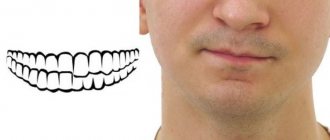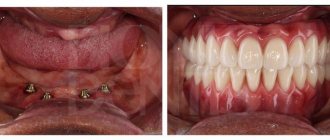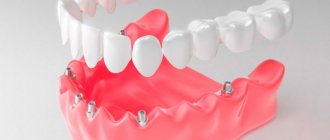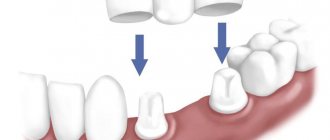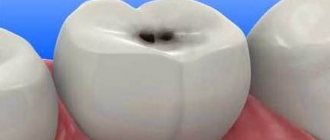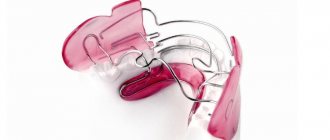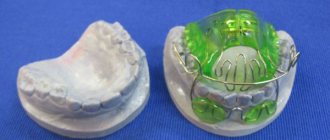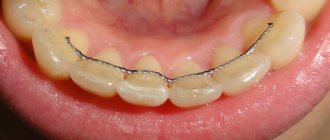Treatment principle
Prosthetics can be performed if the following defects are detected in the oral cavity:
- Too noticeable gaps between teeth.
- Too large or, conversely, small sizes of individual units.
- Chips, cracks, breaks.
For minor defects, you can get by with the installation of veneers or lumineers. They are very thin plates that are made of composite or porcelain. They completely cover the front surface of their tooth. It is first necessary to grind the tooth, this will allow the veneer to look more natural.
Installing a crown allows you to solve a wider range of problems, while pathologies can be more pronounced. Most often, installation is recommended for very large lesions, when it comes to complete tooth extraction.
The following factors can lead to malocclusion:
- Too early loss of back molars or primary front teeth.
- Presence of bad habits (thumb sucking, pacifier or other objects).
- Loss of teeth due to health conditions or injury.
If the crown is placed in a timely manner, the risk of disruption of chewing functions and digestive problems will be minimized.
Purpose of crowns:
- Protection from more serious damage.
- Additional protection for implanted implants.
- They can come to the rescue if you receive a very severe injury, as well as with severe caries.
Stages of treatment
- To correct the bite using this method, the patient will need to visit the clinic at least twice. Stages: First of all, a detailed diagnosis will be carried out and tests will be taken. This will allow you to determine the general condition of the oral cavity and determine the course of further treatment.
- After the dentures or veneers are ready, a person needs to go to the dentist to fix them.
- Any further visits to the doctor may be necessary if discomfort or pain occurs.
Removable dentures
Also, to eliminate bite problems, you can use more budget-friendly treatment options - installing removable dentures.
Prosthetics are recommended in the following situations:
- Shortened and disproportionate lower teeth.
- The upper teeth overlap the lower jaw by more than a third.
- Impaired diction, inability to pronounce certain letters.
- Too much worn enamel.
- A noticeable protrusion of the upper or lower lip.
- Strong crunching or clicking sounds when chewing.
Removable dentures are an ideal solution for patients with complete or partial edentia. A complete removable denture is ideal for the upper jaw; it is firmly fixed due to the suction effect. In the lower jaw, it is recommended to save at least one of your teeth, on which a partial denture can be attached in the future.
Contraindications
In some cases, a patient may be denied prosthetics, for example, due to:
Strong contact of teeth with the prosthesis, as a result of which they can wear out even more.
Rapid wear of the prosthesis. This may cause too much pressure and uneven loading.
It is important to understand that there are quite a few contraindications to the installation of dentures to correct the bite:
- A very strong violation. In such cases, only surgery can help.
- The patient has serious diseases, for example, tuberculosis, HIV infection, cancer, etc.
- The presence of dental problems, for example, inflammatory processes in the oral cavity or severe caries. These pathologies are rather relative, but they must be eliminated before any further intervention. Otherwise, the situation may only get worse.
Other useful material
Implantation of several teeth in a row
Implant installation
How do older age and concomitant diseases affect dental implantation?
7 problems with dental implantation and reasons for failure
Other methods of bite restoration
Modern dentistry offers a large arsenal of techniques for correcting bites. Experienced orthodontists use different designs depending on the complexity of each specific situation and the wishes of the patient. Let's look at the most popular orthodontic structures below.
Braces
The most common non-removable structures, made from a variety of materials to suit any budget (metal, plastic, ceramics, etc.) guarantee the achievement of the desired treatment results in the shortest possible time with a lower risk of relapse. Equally effective in both simple and very complex cases.
The only drawback is the visibility of braces when communicating with others, as well as the presence of slight discomfort when wearing them.
Aligners or aligners
These structures are removable, so more patients prefer their installation. They are made from hypoallergenic plastic or silicone, they are completely transparent and do not affect their appearance in any way.
Trainers
Another removable design that allows you to cope with minor bite pathologies. It is especially effective in childhood, when the jaw bones are not yet fully strengthened and formed. If there is one drawback, you cannot talk, eat or drink while wearing it.
Operation
Preference for this method is given only in the most complex and advanced cases, when no other method of bite correction can guarantee the desired effect. After surgery, braces or wearing removable structures may also be prescribed.
previous post
Photos of bite correction before and after
next entry
Is it possible to do dental prosthetics if there is an incorrect bite?
Consequences of malocclusion
Prosthetics for malocclusion
When are braces needed before dentures?
Are straight teeth really only for celebrities? Unfortunately, the issue of malocclusion does not end with aesthetics.
What is the reason?
The formation of malocclusion occurs in childhood and develops under the influence of certain factors: the presence of a narrow underdeveloped jaw, unusually large teeth, displacement as a result of the removal of baby teeth without the subsequent installation of dentures or the child’s bad habits (thumb sucking), as well as the germination of “wisdom” teeth " Parents are required to pay attention to the dental health of their children. You can cure a malocclusion in childhood using special massage and gymnastics.
What are the consequences?
The development of malocclusion is fraught with unpleasant health consequences. Firstly, the temporomandibular joint may be impaired, which often leads to headaches and painful sensations while eating. Secondly, there may be a violation of diction. Thirdly, malocclusion often makes it difficult to care for the oral cavity, which leads to the emergence of many dental problems. Fourth, various common diseases can develop: sinusitis, otitis media, flu, colds, gastritis. It is also important that, due to its unaesthetic nature, malocclusion stimulates the development of psychological complexes in a person, which ultimately leads to a decrease in the level of quality of life.
When are braces needed before dentures?
When turning to an orthopedic dentist, a person with an abnormal bite can often hear unexpected words: “You need to get braces.” Orthodontic treatment before prosthetics is prescribed in difficult clinical situations, for example, when jaws are displaced.
There are situations when an adjacent crooked tooth, leaning towards the gap, narrows it so much that it is not possible to install a denture. This happens if the tooth was removed a long time ago - this is why dentists advise not to postpone prosthetics or implantation for a long time, since the complexity and cost of the procedure increases in proportion to the time elapsed after the removal.
Each patient’s case is unique, and dentists each time select an individual solution to the problem assigned to them. There are no universal methods, which is why it is impossible to unequivocally answer the question: “Is it possible to have dentures for teeth with malocclusion?” During the consultation, the specialist examines the oral cavity, examines diagnostic photographs and casts, and, based on the information received, selects treatment.
Rules for installing crowns
After removing braces, crowns are placed on those dental units that cannot be filled or restored by other means. In order for microprostheses to serve for a long time, it is important to follow the following rules.
- Place a crown on a tooth that is in the correct position. If it is displaced, the lifespan of the restoration may be shortened.
- Select the correct crown material. So, for patients with metal allergies, a metal-free design would be the best option.
- Follow the rules of prosthetics - correctly prepare the teeth, make a crown based on an impression, adjust it for a comfortable fit and fix it with durable dental cement.
Installing crowns after removing braces will not affect the result of orthodontic treatment provided that retainers are worn, since the retention apparatus will not allow the teeth to return to their previous position. The period of wearing a crown is 10-15 years. Then the microprosthesis must be replaced.
Prosthetics for malocclusion
Dental prosthetics for malocclusion is a complex task that can only be solved on an individual basis. A thorough diagnosis is required, including computed tomography, orthopantomogram, and jaw casts. If you do not take into account all the nuances, prosthetics for an incorrect bite can lead to the fact that the crowns will not last long - due to overload, they can break and chip. At the same time, those teeth that come into contact with the crowns will wear down even more under the pressure of the hard crown material.
How long does it take to correct a deep bite?
The most favorable period of treatment is childhood and adolescence. Therefore, a child’s deep bite can be corrected in a shorter period of time (from 3 to 6 months) and does not require the use of retention devices. Treatment of deep bite in adults takes an average of 5-6 years: 3-4 years - active correction and 1-2 years - restorative therapy.
The different times and effectiveness of correction are due to the plasticity of the child’s skeletal system and the ongoing formation of the dental system, which facilitates therapy and allows the use of gentle techniques.
